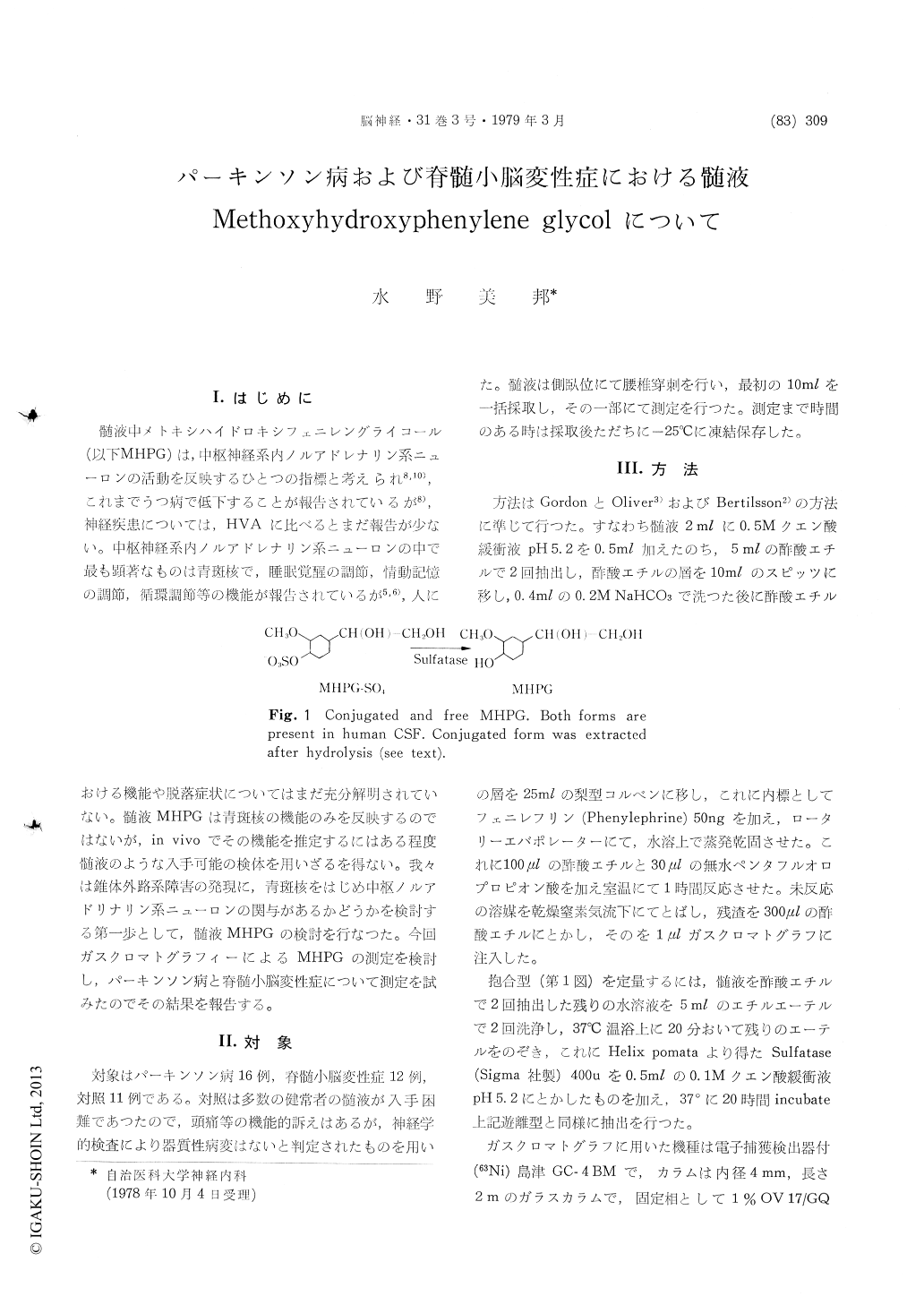Japanese
English
- 有料閲覧
- Abstract 文献概要
- 1ページ目 Look Inside
I.はじめに
髄液中メトキシハイドロキシフェニレングライコール(以下MHPG)は,中枢神経系内ノルアドレナリン系ニューロンの活動を反映するひとつの指標と考えられ8,10),これまでうつ病で低下することが報告されているが8),神経疾患については,HVAに比べるとまだ報告が少ない。中枢神経系内ノルアドレナリン系ニューロンの中で最も顕著なものは青斑核で,睡眠覚醒の調節,情動記憶の調節,循環調節等の機能が報告されているが5,6),人における機能や脱落症状についてはまだ充分解明されていない。髄液MHPGは青斑核の機能のみを反映するのではないが,in vivoでその機能を推定するにはある程度髄液のような入手可能の検体を用いざるを得ない。我々は錐体外路系障害の発現に,青斑核をはじめ中枢ノルアドリナリン系ニューロンの関与があるかどうかを検討する第一歩として,髄液MHPGの検討を行なつた。今回ガスクロマトグラフィーによるMHPGの測定を検討し,パーキンソン病と脊髄小脳変性症について測定を試みたのでその結果を報告する。
Cerebrospinal fluid (CSF) methoxyhydroxy-phenylene glycol (MHPG) is considered to reflect activities of the central nervous system nor-adrenergic neurons. Among the noradrenergic systems the largest nucleus is the locus coeruleus, functions of which have not yet been wholly elucidated. CSF MHPG is said to be reduced in depression. Not many studies have been done on CSF MHPG in neurological disorders. We wanted to see to what extent CNS noradrenergic systems are involved in the pathogenesis of extrapyramidal sysmtoms and disorders. For this purpose CSF MHPG was measured in patients with Parkinson'sdisease and spinocerebellar degeneration.
CSF MHPG was assayed by a sensitive gas chromatographic method with electron capture detection as described by Gordon & Oliver and Bertilsson.
CSF free MHPG in control, Parkinson's d±isease and spinocerebellar degeneration were 8.8 ± 2.6 (n=11), 6.9±2.5 (n=16) and 7.0 ±3.4 (n=12) and total MHPG 11.4±2.2, 9.1 ±2.8 and 9.9 ± 4.1 respectively (ng/ml, m±S. E.). Free MHPG in patients with Parkinson's disease was lower than that of the control (p <0.1) and total MHPG sig-nificantly lower than the control (p <0.05). There were no statistically significant differences between the spinocerebellar degeneration and the control. However, when the cases were broken down ac-cording to the differences of clinical types, patients with olivopontocerebellar atrophy (OPCA) showed lower values, i. e. CSF MHPG for OPCA, LCCA (late cerebellocortical atrophy) and for those with clinical diagnosis of dentate-rubro-pallido-luysian atrophy (DPLA) were 8.6 ±2.0 (n=5), 10.4 ±1.4 (n=4) and 11.5 ±3.3 (n=3) respectively (ng/ml, m ±S. E.). There was a tendency that patients with significant orthostatic hypotension had low MHPG levels.
Decrease of CSF MHPG would indicate dys-functions of central noradrenergic systems. Because the locus coeruleus is the largest noradrenergic nucleus sending axons to all most every brain areas, activities of this nucleus may be reflected as changes in spinal MHPG levels to some extent, however, one had to keep it in mind that spinal nor-adrenergic systems would also contribute to spinal MHPG. Diminished CSF MHPG levels seemed to be associated with automonic dysfunctions in our cases.
Previously we found that CSF HVA was di-minished in OPCA and DPLA in addition to Parkinson's disease. CSF MHPG was reduced in OPCA but not in DPLA. Both HVA and MHPG were normal in LCCA. There differences are probably representing the differences of the areas involved and studies of these monoamine metabolites may help the diagnosis in cases where clinical differenciation is difficult.

Copyright © 1979, Igaku-Shoin Ltd. All rights reserved.


